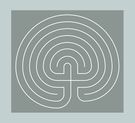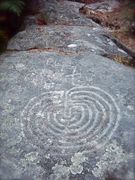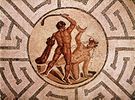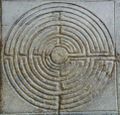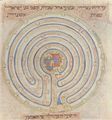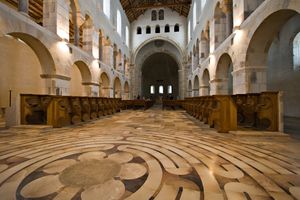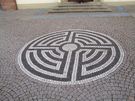متاهة

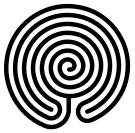
المتاهة أو قصر التيه (Greek λαβύρινθος labyrinthos ، إنگليزية: Labyrinth) الأرض التي يتوه فيها السالك ولايكاد يعرف فيها طريقا. ويراد بها في الأساطير مبنى التّيه ذو الممرات الفرعية المعقدة الذي بناه ديدالوس للملك مينوس ملك كريت، حسب الأسطورة الإغريقية، وأراد مينوس أن يجعل منها سجنًا للوحش الذي يسمى المينطور. إذ كان يضحَّى بسبعة من شباب أثينا، وسبع عذارى لهذا الوحش كل سنة.
ذهب ثسيوس ابن الملك الأثيني إلى تلك المتاهة وقتل الوحش، وتمكَّن من شق طريقه إلى الخارج خلال الممرات الفرعية الملتوية. وكانت أريادنه، ابنة مينوس قد أعطت ثسيوس كرة من الخيوط، لينشرها في طريقه إلى الداخل، ثم يتعقب هذه الخيوط ويسير باتجاهها عند هَرَبه.
وقد اكتشف علماء الآثار قصرًا ربما كان هو مكان المتاهة الكريتية. إذ تم اكتشافه في المدينة الكريتية كنوسوس ويحتوي المكان على ممرات وطرق فرعية عديدة ويشبه المتاهة الأسطورية. وعثر على فؤوس كثيرة ذات رؤوس مزدوجة في القصر. ويعتقد معظم العلماء أن كلمة متاهة كانت تعني في الإغريقية الفأس ذات الرأس المزدوج. وأصبحت تعني المكان الذي يحتوي على طرق وممرات عديدة معقدة. كما عثر علماء الآثار على بقايا متاهة كبيرة أخرى في مصر.
قصور التيه القديمة
يذكر پلني الأكبر في كتابه التاريخ الطبيعي أربع قصور تيه قديمة: قصر التيه الكريتي، قصر التيه المصري، قصر التيه اللمني وقصر التيه الإيطالي.
هيرودوت عن قصر التيه المصري
Even more generally, labyrinth might be applied to any extremely complicated maze-like structure. Herodotus, in Book II of his Histories, describes as a "labyrinth" a building complex in Egypt, "near the place called the City of Crocodiles," that he considered to surpass the pyramids in its astonishing ambition:
It has twelve covered courts — six in a row facing north, six south — the gates of the one range exactly fronting the gates of the other. Inside, the building is of two storeys and contains three thousand rooms, of which half are underground, and the other half directly above them. I was taken through the rooms in the upper storey, so what I shall say of them is from my own observation, but the underground ones I can speak of only from report, because the Egyptians in charge refused to let me see them, as they contain the tombs of the kings who built the labyrinth, and also the tombs of the sacred crocodiles. The upper rooms, on the contrary, I did actually see, and it is hard to believe that they are the work of men; the baffling and intricate passages from room to room and from court to court were an endless wonder to me, as we passed from a courtyard into rooms, from rooms into galleries, from galleries into more rooms and thence into yet more courtyards. The roof of every chamber, courtyard, and gallery is, like the walls, of stone. The walls are covered with carved figures, and each court is exquisitely built of white marble and surrounded by a colonnade.[1]
أثناء القرن التاسع عشر، تم اكتشاف بقايا قصر التيه على بعد "11 1/2 ميل من هرم الهوارة/ في محافظة الفيوم."[2] The Labyrinth was likely modified and added upon "at various times. The names of more than one king have been found there, the oldest" name being that of Amenemhat III.[2] "It is unnecessary to imagine more than that it was monumental, and a monument of more than one king of Egypt."[2]
In 1898, the Harpers Dictionary of Classical Antiquities described the structure as "the largest of all the temples of Egypt, the so-called Labyrinth, of which, however, only the foundation stones have been preserved."[3]
Herodotus' description of the Egyptian Labyrinth, in Book II of The Histories, inspired some central scenes in Bolesław Prus' 1895 historical novel Pharaoh.
توجد أبنية تحتوي على شبكة من الممرات والطرق الفرعية التي لا نهاية لها في بعض حدائق الترويح، وتسمَّى المتاهة، وتُستخدم لاختبار المهارة في حل المعضلة. إذ إن كثيرًا من الألعاب والتمارين المسلية تقوم أساسًا على فكرة المتاهة، وتستخدم أيضًا في التجارب لاختبار ردود الفعل عند الحيوانات.
Earliest recovered labyrinth, incised on a clay tablet from Pylos.
Minotaur in Labyrinth—a Roman mosaic at Conímbriga, Portugal.
Wall maze in Lucca Cathedral, Italy (probably medieval).
Seven-ring classical labyrinth of unknown age in Rocky Valley near Tintagel, Cornwall, UK.
Public hedge maze in "English Garden" at Schönbusch Park, Aschaffenburg, ألمانيا.
Small turf maze near Dalby, North Yorkshire, UK.
Turf maze at Wing in Rutland, UK.
9/11 memorial labyrinth, Boston College, USA.
Edinburgh labyrinth, George Square Gardens, Edinburgh, Scotland, UK
Illustration of Jericho in a Farhi Bible (14th century)
قصور تيه القصور الوسطى ومتاهات الزمام
قصو تيه حديثة

In recent years, there has been a resurgence of interest in the labyrinth symbol, which has inspired a revival in labyrinth building, notably at Willen Park, Milton Keynes; Grace Cathedral, San Francisco; Tapton Park, Chesterfield; Old Swedes Church in Wilmington; the Labyrinth in Shed 16 in the Old Port of Montreal, and Trinity Square in Toronto.
Countless computer games depict mazes and labyrinths.
انظر أيضاً
الهامش
- ^ Herodotus, The Histories, translated by Aubrey de Sélincourt, Book II, pp. 160-61.
- ^ أ ب ت Leonhard Schmitz, George Eden Marindin, Labyrinthus entry, in William Smith et al. (editors), Dictionary of Greek and Roman Antiquities, published 1890.
- ^ Peck, Harry Thurston (chief editor). "Hieratic Papyrus. (Twentieth Dynasty.)" in the Harpers Dictionary of Classical Antiquities, published 1898, page 29.
المصادر
- Hermann Kern, Through the Labyrinth, ed. Robert Ferré and Jeff Saward, Prestel, 2000, ISBN 3-7913-2144-7. (This is an English translation of Kern's original German monograph Labyrinthe published by Prestel in 1982.)
- Penelope Reed Doob, The Idea of the Labyrinth: from Classical Antiquity through the Middle Ages, Cornell University Press, 1992, ISBN 0-80142-393-7.
- Herodotus, The Histories, Newly translated and with an introduction by Aubrey de Sélincourt, Harmondsworth, England, Penguin Books, 1965.
- Karl Kereny, Dionysos: Archetypal Image of Indestructible Life, Princeton University Press, 1976.
- Helmut Jaskolski, The Labyrinth: Symbol of Fear, Rebirth and Liberation, Shambala, 1997.
- Adrian Fisher & Georg Gerster, The Art of the Maze, Weidenfeld & Nicolson, 1990. ISBN 0-297-83027-9.
- Jeff Saward, Labyrinths and Mazes, Gaia Books Ltd, 2003, ISBN 1-85675-183-X.
- Jeff Saward, Magical Paths, Mitchell Beazley, 2002, ISBN 1-84000-573-4.
- W.H. Matthews, Mazes and Labyrinths: Their History and Development, Longmans, Green & Co., 1922. Includes bibliography. Dover Publications reprint, 1970, ISBN 0-486-22614-X.
- Andrew Stewart, One Hundred Greek Sculptors: Their Careers and Extant Works.
- Henning Eichberg, 2005: "Racing in the labyrinth? About some inner contradictions of running." In: Athletics, Society & Identity. Imeros, Journal for Culture and Technology, 5:1) Athen: Foundation of the Hellenic World, 169-192.
- Edward Hays, The Lenten Labyrinth: Daily Reflections for the Journey of Lent, Forest of Peace Publishing, 1994.
وصلات خارجية
- Labyrinthos maintained by Jeff Saward
- The Labyrinth Society
- Through Mazes to Mathematics Exposition by Tony Phillips, SUNY
- Maze classification Extensive classification of labyrinths and algorithms to solve them.
- IRRGARTENWELT.DE Lars O. Heintel's collection of handdrawn labyrinths and mazes
- Labyrinthe in Deutschland Website (in German) with diagrams and photos of virtually all the public labyrinths in Germany.
- Mystery Labyrinth German website (in German and English) with descriptions, animations, links, and especially photos of (mostly European) labyrinths.
- British turf labyrinths by Marilyn Clark. Photos and descriptions of the surviving historical turf mazes in Britain.
- Jo Edkins's Maze Page An early website providing a clear overview of the territory and suggestions for further study.
- "Die Kretische Labyrinth-Höhle" by Thomas M. Waldmann, rev. 2009 (in German, English, French, and Greek). Description of a labyrinthine artificial cave system near Gortyn, Crete, widely considered (before the discovery of Knossos) the original labyrinth on Crete. (Presentation somewhat amateurish – including <blink> tags – but many detailed photos.)
- SpiralZoom.com an educational website about the science of pattern formation, spirals in nature, and spirals in the mythic imagination & labyrinths.
- Guerrilla Labyrinths Light-weight site by David Brazzeal, who creates "occasional" labyrinths.
- The Geometry of History A short overview by Tessa Morrison, U. of Newcastle, Australia.
- Labyrinth- A Sacred Walk The Ursulines Sisters construct a Labyrinth - Canfield, Oh
